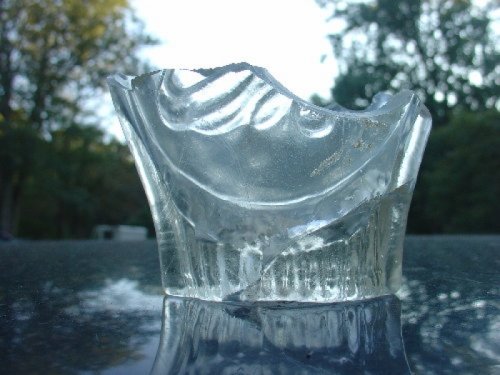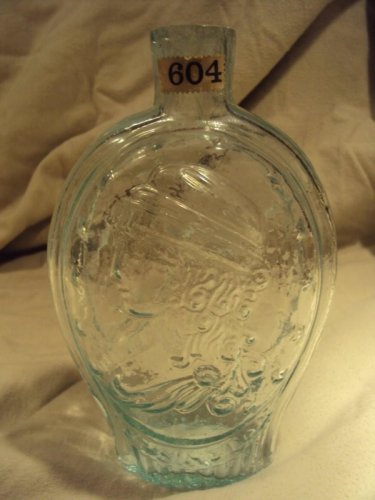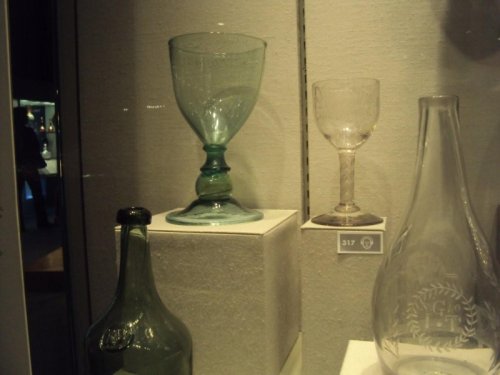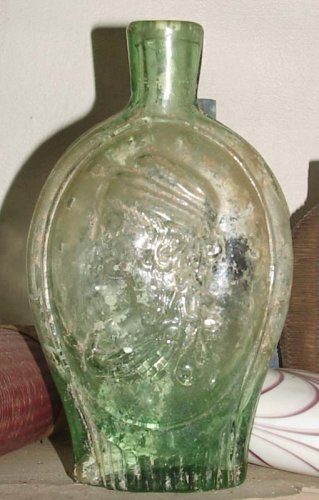Steve/sewell
Well-Known Member
- Joined
- Jan 23, 2010
- Messages
- 6,108
- Reaction score
- 5
- Points
- 0
I have studied Amelungs and Stiegels glass very closely the last four years and the flint glass from both factory's eventually turn lavender with time.Mike you posted in my Columbia flask topic from a few days ago in the historical bottles glass Website portion of the forum that the lavender versions you have seen are stunning in look.With that said I offer the following hypothesis and how lavender glass really comes about as a color.
Manganese, the glassmakers soap" was used in differing quantities as a clarifying agent as long as glass has been blown. The natural color of glass is dependant on the impurities in the glass batch and will normally have a greenish or brown cast (see early bottles). Manganese clarifies the impurities to make it clear. It's also the chemical that makes purple glass purple (depending on quantity). Clear Flint glass will turn, but because of the flint, and the iron oxide, it will turn a grayish lavender instead of the deeper purples seen in soda lime glass.This is the case with a partial Columbia flask posted by forum member cobaltbot on my Columbia post in this same section.
I believe the flask that cobaltbot shows pictured might very well had been made in Philadelphia at the old Kensington glass works much earlier then current attribution asertains.Flint glass was not made or used at any of the glass works in Philadelphia or New Jersey after 1795 and not again until 1829 when Dr Dyott reintroduced it to the Philadelphia market.Being the fact that the later Columbia flasks have the Union Glass works stamped on them and that the Union Glass works were in fact the old Kensington glass works started in 1771.It stands to reason that the original flask made in this mold might be older, much older then previously thought and you can see that it is identical to Amelungs glass 1785 to 1795 in color Lavender grey and clarity.The style of this flask also copies the British and Northern European styles very closely with the tapered bottom and the vertical ribbing.It is entirely possible that this flask may very well have been made in the late 1790s or very early 1800s based on the following facts.
In 1791, three commissioners appointed by President Washington named the area destined for the seat of the U.S. government "the Territory of COLUMBIA"; it was subsequently (1801) organized as the District of Columbia.
In 1792, the Columbia Rediviva sailing ship gave its name to the Columbia River in the American Northwest.
In 1798, Joseph Hopkinson wrote lyrics for Philip Phile's 1789 inaugural "President's March" under the new title of "Hail, Columbia." Once used as de facto national anthem of the United States, it is now used as the entrance march of the Vice President of the United States.
In part, the more frequent usage of the name Columbia reflected a rising American neoclassicism, exemplified in the tendency to use Roman terms and symbols. The selection of the EAGLE as the national bird, the use of the term Senate to describe the upper house of Congress, and the naming of Capitol Hill and the Capitol building were all conscious evocations of Roman precedents.
I capitalized the words COLUMBIA and EAGLE as the basis of my theory.Historical Flasks have had a history of portraying National events either during or slightly after they occur because of National fervor at the time of any given event.What event was greater to this country then the selecting of a new capitol city by President Washington and his commissioners.
At the height of the American Revolution, Miss Columbia, "came to represent the spirit of the country and American ideals.Just before Britain and the United States waged the War of 1812, Miss Columbia began appearing in political cartoons in the 18008 to 1810 time period.Based on this historical information,the lavender color of the Columbia flasks most likely flint in makeup,void of the embossing Union glass works on the flask. Is it not possible these flasks were made sometime between 1795 and 1812 in Philadelphia and were in fact our first historical flasks. Most of our historical flasks depicting National events occured in short time either during or just after the moment.Why should it be any different with this flask.It is entirely possible that Mckearin and all the other glass historians who did a remarkable job charting these flasks like they did simply did not gather enough information about this flask when rationalizing the ones not marked Kennsington.
I would like to hear from all of you or any of the forum members who wish to join in as to your thought's as to why or why not this theory is sound or not. Here is a picture of the partial Columbia flask cobaltbot found.

Manganese, the glassmakers soap" was used in differing quantities as a clarifying agent as long as glass has been blown. The natural color of glass is dependant on the impurities in the glass batch and will normally have a greenish or brown cast (see early bottles). Manganese clarifies the impurities to make it clear. It's also the chemical that makes purple glass purple (depending on quantity). Clear Flint glass will turn, but because of the flint, and the iron oxide, it will turn a grayish lavender instead of the deeper purples seen in soda lime glass.This is the case with a partial Columbia flask posted by forum member cobaltbot on my Columbia post in this same section.
I believe the flask that cobaltbot shows pictured might very well had been made in Philadelphia at the old Kensington glass works much earlier then current attribution asertains.Flint glass was not made or used at any of the glass works in Philadelphia or New Jersey after 1795 and not again until 1829 when Dr Dyott reintroduced it to the Philadelphia market.Being the fact that the later Columbia flasks have the Union Glass works stamped on them and that the Union Glass works were in fact the old Kensington glass works started in 1771.It stands to reason that the original flask made in this mold might be older, much older then previously thought and you can see that it is identical to Amelungs glass 1785 to 1795 in color Lavender grey and clarity.The style of this flask also copies the British and Northern European styles very closely with the tapered bottom and the vertical ribbing.It is entirely possible that this flask may very well have been made in the late 1790s or very early 1800s based on the following facts.
In 1791, three commissioners appointed by President Washington named the area destined for the seat of the U.S. government "the Territory of COLUMBIA"; it was subsequently (1801) organized as the District of Columbia.
In 1792, the Columbia Rediviva sailing ship gave its name to the Columbia River in the American Northwest.
In 1798, Joseph Hopkinson wrote lyrics for Philip Phile's 1789 inaugural "President's March" under the new title of "Hail, Columbia." Once used as de facto national anthem of the United States, it is now used as the entrance march of the Vice President of the United States.
In part, the more frequent usage of the name Columbia reflected a rising American neoclassicism, exemplified in the tendency to use Roman terms and symbols. The selection of the EAGLE as the national bird, the use of the term Senate to describe the upper house of Congress, and the naming of Capitol Hill and the Capitol building were all conscious evocations of Roman precedents.
I capitalized the words COLUMBIA and EAGLE as the basis of my theory.Historical Flasks have had a history of portraying National events either during or slightly after they occur because of National fervor at the time of any given event.What event was greater to this country then the selecting of a new capitol city by President Washington and his commissioners.
At the height of the American Revolution, Miss Columbia, "came to represent the spirit of the country and American ideals.Just before Britain and the United States waged the War of 1812, Miss Columbia began appearing in political cartoons in the 18008 to 1810 time period.Based on this historical information,the lavender color of the Columbia flasks most likely flint in makeup,void of the embossing Union glass works on the flask. Is it not possible these flasks were made sometime between 1795 and 1812 in Philadelphia and were in fact our first historical flasks. Most of our historical flasks depicting National events occured in short time either during or just after the moment.Why should it be any different with this flask.It is entirely possible that Mckearin and all the other glass historians who did a remarkable job charting these flasks like they did simply did not gather enough information about this flask when rationalizing the ones not marked Kennsington.
I would like to hear from all of you or any of the forum members who wish to join in as to your thought's as to why or why not this theory is sound or not. Here is a picture of the partial Columbia flask cobaltbot found.








